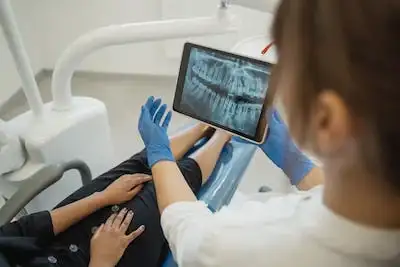Assessing the Damage:
Before diving into treatment options, understanding the extent of the damage is key. A dentist will conduct a thorough examination, including X-rays, to determine the severity of the break, potential nerve involvement, and overall tooth structure.
Minor Chips and Cracks: These often involve the enamel layer, the hard outer shell of the tooth. Chipped front teeth can be purely cosmetic, while cracks extending deeper might require intervention to prevent further breakage.
Moderate Fractures: These involve deeper cracks impacting the dentin, the softer layer beneath the enamel. Fractures can cause sensitivity and pain, especially when chewing.
Severe Breaks: These involve significant tooth loss, reaching the pulp chamber and potentially exposing the nerve. Severe breaks often cause intense pain and require immediate attention.
Repairing the Damage:
Once the diagnosis is clear, your dentist will recommend the most suitable treatment option based on the severity of the damage, your specific needs, and budget. Here's a breakdown of the most common repair methods:
1.Dental Fillings:
For: Minor chips, cracks, and cavities.
Procedure: The dentist removes decayed or damaged tooth material and fills the cavity with a biocompatible resin material. The filling is hardened with a special light, restoring the tooth's shape and function.
Benefits: Affordable, minimally invasive, durable, and often requires no anesthesia.
Drawbacks: May not be suitable for large fractures or areas under significant chewing pressure.
2.Dental Bonding:
For: Chipped or cracked front teeth, memperbaiki minor gaps or discolored teeth.
Procedure: The dentist roughens the tooth surface and applies a tooth-colored composite resin. The resin is sculpted and molded to match the natural tooth and hardened with a light.
Benefits: Cost-effective, preserves more natural tooth structure than crowns, good aesthetic outcome.
Drawbacks: May not be as durable as fillings, especially in high-stress areas, and may stain over time.
3.Dental Crowns:
For: Severely cracked or broken teeth, teeth with large fillings, or those requiring root canal therapy.
Procedure: The dentist prepares the tooth by removing damaged material and shaping it to receive the crown. A custom-made cap, usually made of porcelain or metal, is then cemented onto the remaining tooth structure.
Benefits: Strongest and most durable option, restores full functionality and appearance, protects weakened teeth.
Drawbacks: More expensive than fillings or bonding, requires removal of more tooth structure, and may not match the natural tooth color perfectly.
4.Dental Veneers:
For: Chipped, cracked, discolored, or misaligned front teeth.
Procedure: Thin shells of porcelain or composite resin are bonded to the front surface of the teeth, masking imperfections and creating a cosmetically pleasing smile.
Benefits: Excellent aesthetic results, minimally invasive, can address multiple cosmetic concerns simultaneously.
Drawbacks: More expensive than bonding, may not be as durable as crowns, and require removal of a small amount of enamel.
5.Root Canal Therapy:
For: Teeth with severely damaged pulp containing infected nerves or bacteria.
Procedure: The dentist removes the infected pulp tissue, cleans and disinfects the root canals, and fills them with a biocompatible material. A crown is often placed afterward to protect the weakened tooth.
Benefits: Saves the natural tooth from extraction, alleviates pain and prevents further infection.
Drawbacks: More complex and expensive than other procedures, can be uncomfortable, and may require multiple appointments.
6.Dental Implants:
For: Severely damaged or missing teeth, when other options are not viable.
Procedure: A small titanium screw is surgically implanted into the jawbone to act as an artificial tooth root. A crown is then attached to the implant, creating a natural-looking and functional replacement tooth.
Benefits: Most durable and natural-looking option for replacing missing teeth, restores

